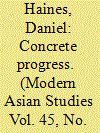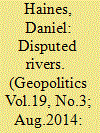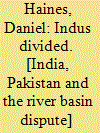| Srl | Item |
| 1 |
ID:
102056


|
|
|
|
|
| Publication |
2011.
|
| Summary/Abstract |
The idea of 'developing' Sind has been a lynchpin of government action and rhetoric in the province during the twentieth century. The central symbols of this 'development' were three barrage dams, completed between 1932 and 1962. Because of the barrages' huge economic and ideological significance, the ceremonies connected with the construction and opening of these barrages provide a unique opportunity to examine the public presentation of state authority by the colonial and postcolonial governments. This paper investigates the way that ideas of 'development' and 'modernity' appeared in discourses connected with these ceremonies, in order to demonstrate that the idea of imposing 'progress' on a province considered 'backward' by the state administrators survived longer than the British regime which had introduced it. The paper begins with the historical links between water-provision and governance in Sind, before examining the way that immediate political concerns of the sitting governments were addressed in connection with the projects, demonstrating the ways in which very similar projects were cast as symbols of different political priorities. The last part of the paper draws out deeper similarities between the logic of these political expressions, in order to demonstrate the powerful continuity in ideologies of 'progress' throughout mid-twentieth century Sind.
|
|
|
|
|
|
|
|
|
|
|
|
|
|
|
|
| 2 |
ID:
134631


|
|
|
|
|
| Summary/Abstract |
The construction of territorial sovereignty is key to conceptions of modern states. Yet after the Partition of India and Pakistan in 1947, when both became independent from Britain, the precise nature of India’s relationship to Pakistan was open to some question. Was Pakistan a foreign country? Was India’s relationship to it international? This article uses the example of a dispute over water resources in the Indus Basin to highlight the process through which Indian officials in New Delhi’s External Affairs and Law ministries came to define Pakistan as constitutionally, as well as geographically, “outside” India between 1948 and 1951. Yet while Indian policy makers manoeuvred into an aggressive stance against Pakistan, both countries’ membership of the British Commonwealth implied an international relationship blurring the formal distinction between “domestic” and “foreign”. Negotiating the contradictions between Commonwealth rules and the desire to assert sovereignty over territory and resources, I argue, made Indian sovereignty contingent on circumstance.
|
|
|
|
|
|
|
|
|
|
|
|
|
|
|
|
| 3 |
ID:
152373


|
|
|
|
|
| Publication |
Gurgaon, Penguin Randam House India Pvt. Ltd., 2017.
|
| Description |
xi, 264p.hbk
|
| Standard Number |
9780670089628
|
|
|
|
|
|
|
|
|
|
|
|
Copies: C:1/I:0,R:0,Q:0
Circulation
| Accession# | Call# | Current Location | Status | Policy | Location |
| 059005 | 341.442/HAI 059005 | Main | On Shelf | General | |
|
|
|
|